Labor Day 1997 Flower Gardens Trip Report
Text and images Copyright (C) 1997 David M. Read. All rights reserved.
From 30 Aug 1997 to 1 Sep 1997, my wife and I dove the Flower Gardens Banks National
Marine Sanctuary, aboard the M/V Fling. This is a report of that dive trip.
All of the images below are hyperlinked. Click on any image to see a larger version.
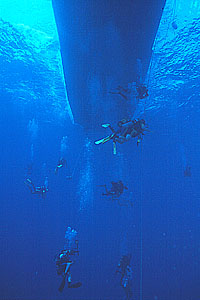 |
This trip started out looking very promising. A huge
high-pressure area had lodged itself over the Gulf of Mexico, and the nearest storm (just
a regular storm, not a hurricane) was over the middle of Cuba. All of this made us think
that we were in for good weather, calm seas, and good dive conditions. For the most part,
we were not disappointed. We were a little surprised (and a little disappointed) when
we arrived at the dock on Friday night, only to discover that our boat assignment had been
switched. In 1996, we sailed on the M/V Spree, and we were supposed to be on
the Spree again this year. However, when we got to the dock, we were told that some
juggling had been done, and our dive shop's passengers had been reassigned to the Fling.
No biggie, except that the repeat-customer business is pretty strong around Labor Day, and
we knew that some of the friends we had made on the previous year's trip would be on the Spree.
As we discovered later, however, a significant portion of last year's people ended up on
the Fling, so we couldn't complain too much. |
I won't go into details on the dive operation here; you can read about the boats in one
of the other Flower Gardens trip reports (Labor
Day 1996, February 1997). The M/V Fling
is laid out basically the same way the M/V Spree is. There are a few minor
differences, but not enough to mention.
Random tip: although some people claim that getting a berth amidships reduces
sea-sickness, I still think that the place to be on the Fling and Spree is
in the forward berthing area. The reason for this is that the forward area has its
own head, while the midships area has none (but is within easy reach of the two galley
heads). Who cares? Well, there's always a wait for the galley heads, and the
midships people hardly ever think to check the forward head (after all, it is
belowdecks). As a result, the head in the forward berthing area is almost always empty,
and merely a few feet from your bunk if you're up there. If you can tolerate the pitching
motion up front, it really is the place to be.
| Onto the diving details. For the most part, conditions at the Flower Gardens were
excellent this time around. At West FG Banks, we had 85F water, 80-foot vis, calm
seas, and no current whatsoever. East Banks were similar: 85F water, 60-foot vis, slightly
rougher seas, and only very mild (less than 0.25 knot) currents. Stetson Bank was a little
more challenging, especially on the last day of the trip. The water temp sat at 84F,
the vis was a sparkling 100 feet, but the seas got a little higher (maybe 2-3 feet) and
the current picked up. Generally the dives at Stetson were blessed with small (~0.25 knot)
currents, but the last dive at Stetson was a hard-breathing dive with a current of at
least half a knot. Of course, I'm really awful at estimating current speeds, but I can at
least tell you that I had no trouble maneuvering on any dive except that last dive, where
I was able to swim against the current, but I had to want to do it. |
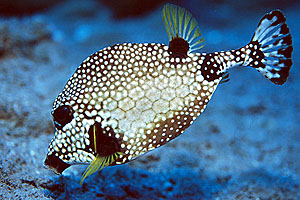 |
This was also the first Flower Gardens trip where I did not see any sort of large
pelagic critters. No whale sharks, no mantas, no spotted eagle rays, no nurse sharks, no
nothing. Other divers saw one or two nurse sharks, but that was about it. Based on my
other experiences, I think this was sort of unusual. Time will tell, as I make more dives
out there.
Don't think that the diving wasn't interesting, though. There were plenty of new and
unusual things on the reef, plus the usual host of fish, eels, crustaceans, etc.
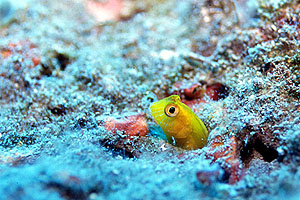
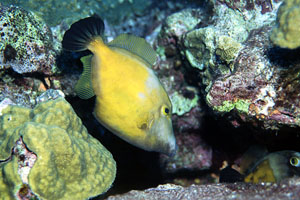
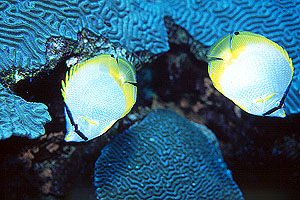
|
There was one annoyance that I must report. Rinn Boats has always enforced a
2.5-hour surface interval between dives. This doesn't bother me; when you do all your
diving in square profiles at 70-80 feet, a nice long surface interval sounds like a good
idea. However, the way the interval worked in the past is this: approximately every
2.5-3.0 hours, the divemaster would hold a short briefing, announce "the dive gate is
open; as soon as your two-and-a-half hours is up, you may feel free to enter the
water," and people would start diving. Apparently someone cheated on the 2.5 hours
within the last year, and got bent. Now Rinn has a new policy regarding divers entering
the water: 2.5 hours after the last diver exited the water from the previous dive, the
dive gate opens and divers can start their dives. The impact of this seemingly small
change is horrendous. Formerly, the divers would bunch up to enter the water on the first
dive, but the spacing would even out on subsequent dives, as different people reached
their 2.5 hours at different times. The way it is now, the huge bunch-up of divers waiting
to get in the water occurs every dive! The hang lines get crowded at the end of the
dive, there's always a wait to get on a ladder to exit, the camera hang lines are always
occupied, and getting into and out of the water is generally more of a hassle. Moreover,
the new system stretches out the dive day. The night dive on our first day didn't roll
around until after 10pm, whereas is was around 8 pm last year. Folks, it's very tiring
doing a night dive which ends at 11pm when you're going to get up at 6:30 the next morning
to start diving again! I can't say I'm pleased with the change. If you agree with me
(especially if you have experienced both new and old systems!), please take the time to drop Rinn Boats an email, explaining why you prefer the
old system. |
Here are some excerpts from my dive log:
Dive 1: 7am, Saturday 30 Aug 1997 West Bank
OK dive in general, but my pony tank came loose during the dive, which made for
some interesting equipment adjustments. Returning to the Flower Gardens is the same eye
opener that the first dive of a vacation always is. The "usual suspects" were
out in force at the West Bank: parrot fish, rock beauties, damselfish of several
varieties, black durgons, and huge schools of brown chromis. The highlight of the dive was
watching two parrotfish fight vigorously for about five minutes. |
 |
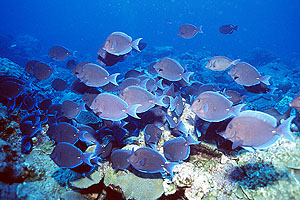 |
Dive 2: 11:00am, Saturday 30 Aug 1997 West Bank
A much better dive all around. Photo ops abounded, especially when a giant school (at
least 50 members) of blue tangs swam right in front of me. Thanks be that I had the 24 mm
lens on the camera! Other participants in the dive: queen angelfish, blue angelfish,
whitespotted filefish, honeycomb cowfish, rock beauties, and more. There's one fish I
can't ID; it looks like a fairy basslet, except that the dorsal side is blue rather than
purple. Looking into the matter, Humann's book IDs it as either a Cocoa Damselfish or a
Beaugregory. The difference is a spot at the base of the tail. I'll keep an eye out on the
next dive... Also saw a few ocean triggerfish cruising around, and a school of chub
(bermuda or orange, I can't tell) hanging out a few feet beneath the boat. |
Dive 3: 3:00pm, Saturday 30 Aug 1997 East Bank
The mystery fish is a cocoa damselfish, identified by a spot at the base of the tail.
Plenty of other fish, including a huge school of some sort of baitfish, and another school
of chub under the boat. Took some pix of a very small moray, which I think is a chestnut
moray. I'll have to wait on the photos to find out for sure. Also say several large (~2
foot) tiger grouper cruising the reef. |
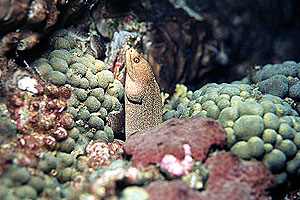 |
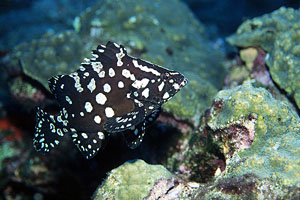 |
Dive 4: 6:30 pm, Saturday 30 Aug 1997 East Bank
Very cool dive. Lots of great stuff, including the largest balloonfish I have ever
seen (at least 2 feet long). I didn't know they got that large! Also saw (and
photographed) a juvenile marbled grouper, quite a beautiful fish. More filefish, too.
Great fun watching a honeycomb cowfish 'digging' in the sand; it blew little jets of water
out of its mouth, and then plucked something out of the sand it had cleared. We watched it
do this for a couple of minutes. |
Dive 5: 10:00pm, Saturday 30 Aug 1997 East Bank
Night Dive! This one was pretty dull, as night dives go. We saw a giant lobster
which I thought was a regular old slipper lobster, but Humann's Reef Creatures book has
convinced me was a Spanish Slipper Lobster. Also saw a giant spiny lobster, lots of little
jumping shrimp, urchins everywhere, christmas tree worms with their "tongues"
extended (never seen that before, so I'm not exactly sure what they are), puffers,
squirrelfish, parrotfish sleeping, a trunkfish on auto-pilot, and a huge pearly white
sponge uncrusting a rock under a ledge. Also saw a tiny juvenile spotted drum.
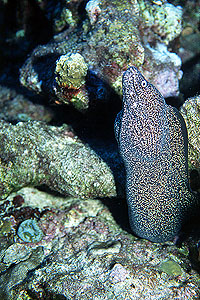 |
Dive 6: 7 am, Sunday 31 Aug 1997 East Bank. Main camera batteries
died during this dive, which cost me some good photo ops. Otherwise a good dive. I did
manage to get a couple of pix of a juvenile spotted drum, and another of the largest
spotted moray I have ever seen (it was about 8 inches in diameter). 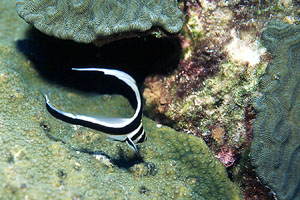
|
Dive 7: 11:00am, Sunday 31 Aug 1997 East Bank
Spent much of the dive looking for the spot on the reef where the spotted drum and the
moray had been. No luck. The winds & currents shifted too much, and the boat swang
around on the mooring line, so basically we were diving a completely different section of
reef. |
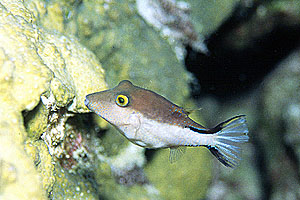 |
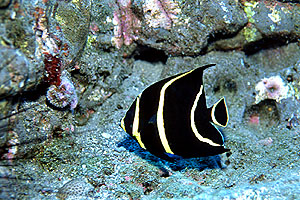 |
Dive 8: 4:00pm, Sunday 31 Aug 1997 Stetson Bank
Stetson is cool, as always. Plenty to see on the "lunar landscape,"
including a scorpionfish, juvenile french and queen angelfish, and giant specimens
of adult queen & french angels. |
Dive 9: 9:00pm, Sunday 31 Aug 1997 Stetson Bank
Night Dive! Lots of urchins and bristle worms, and for some reason, many atlantic deer
cowries out and about. Saw a huge spotted moray free-swimming, lots of hermit crabs, and
two huge decorator crabs. One of the decorator crabs had a sponge the size of a dinner
plate on its back, a sponge which resembled a mantle of amethyst. Brittle stars out
feeding, scallops with their mantles extended, etc.
Dive 10: 7am, Monday 1 Sep 1997 Stetson Bank
All the regular fish, plus a tiny moray sticking its head out of a little nook. Dive
11: 11am, Monday 1 Sep 1997 Stetson Bank
Good dive, but a ripping current made it challenging. We saw five different
scorpionfish, but the highlight of the dive was finding a baby smooth trunkfish, an
autonomous mobile pea-sized fish, black with yellow spots. Very hard to photograph
(focussing difficulties), but entertaining to watch. Got a scare midway through the
dive when I spotted a juvenile queen angel down in a little cluster of rocks. I was
framing up the photo when I felt a sharp prick on my right thigh. When I looked back at my
leg to find out whether I had bumped into rock or coral, I was greeted by a scorpionfish,
dorsal spines extended, right where my leg had been!!! I spent a very anxious thirty
seconds examining my diveskin for holes until I figured that I would have felt the pain
had I been envenomed. |
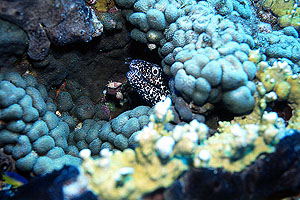 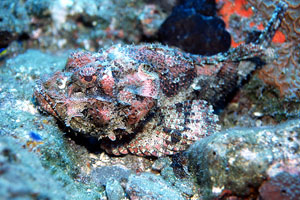
|
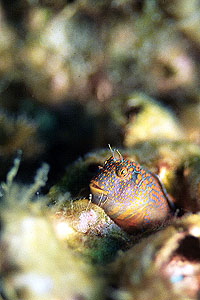 |
Dive 12: 3pm, Monday 1 Sep 1997 Oil Rig 393-C (inshore)
Rig dive! Lots of interesting things to see, including a cluster of tesselated
blennies (great macro subjects), and a leopard toadfish. Visibility sucked (25 feet max),
but currents and surge were light to non-existant, so I can't complain too much. 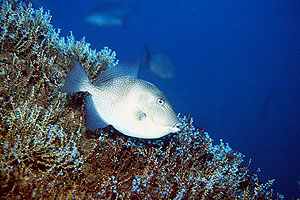
|
Photos which I had no room to include in the text:
Yellowtail snappers
Scorpionfish closeup
Whitespotted filefish
Squirrelfish
Juvenile threespot damselfish
Dive log details:
| Dive # |
When |
Where |
Depth |
Time |
Comments |
| 1 |
7 AM Saturday |
West Bank |
79 |
41 |
Huge school of brown chromis, fighting parrotfish |
| 2 |
11 AM Saturday |
West Bank |
81 |
47 |
Giant school of blue tangs, some ocean triggerfish |
| 3 |
3 PM Saturday |
East Bank |
74 |
50 |
Chestnut moray, tiger groupers |
| 4 |
6:30 PM Saturday |
East Bank |
70 |
47 |
Juvenile marbled grouper, honeycomb cowfish digging
for food |
| 5 |
10 PM Saturday |
East Bank |
74 |
49 |
Night dive! |
| 6 |
7 AM Sunday |
East Bank |
75 |
40 |
Spotted drum, huge spotted moray |
| 7 |
11 AM Sunday |
East Bank |
75 |
48 |
Looked for moray from dive #6 |
| 8 |
4 PM Sunday |
Stetson Bank |
90 |
39 |
Scorpionfish, juvenile french
angel, juvy queen angel |
| 9 |
9 PM Sunday |
Stetson Bank |
84 |
40 |
Night Dive! Free-swimming moray, lots of crabs. |
| 10 |
7 AM Monday |
Stetson Bank |
87 |
42 |
Tiny moray, very cute |
| 11 |
11 AM Monday |
Stetson Bank |
81 |
40 |
Baby smooth trunkfish, lots of scorpionfish |
| 12 |
3 PM Monday |
Oil Rig 393-C |
72 |
40 |
Rig dive! Tesselated blenies, toadfish, ocean triggerfish. |
Photographic Notes:
All the photos in this document were taken by me on this trip. I used a Nikon N90s
(well, actually, an F90x, but they're the same camera) in an Ikelite N90 housing. Some of the
photos were taken with a Nikkor 24mm lens in a dome port, but most were taken with the
micro-Nikkor 60mm lens behind a flat port. This versatile lens does great fish portraits,
and goes down to 1:1 for macro stuff. It's really a dream to work with. All photos were
lit by a single Ikelite
SubStrobe 200 in TTL mode.
I used Fuji Provia 100, downrated to ISO 80, in all of these photos.
Scanning of these photos was done by me, using my brand-new Hewlett-Packard PhotoSmart scanner, a
relatively spiffy unit which can scan slides, negatives, and prints up to 4"x6".
I'm still deciding whether or not to keep the thing, but the first go-round was pretty
promising, so... Anyway, post-scan processing was done with Adobe Photoshop 4.0. As usual,
I tried to keep electronic processing to a minimum: brightness/contrast, color balancing,
cropping. I used Photoshop's "auto levels" tool on just about every image.
Last modified December 28, 1998
|
















